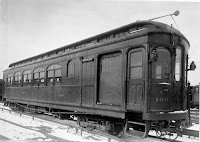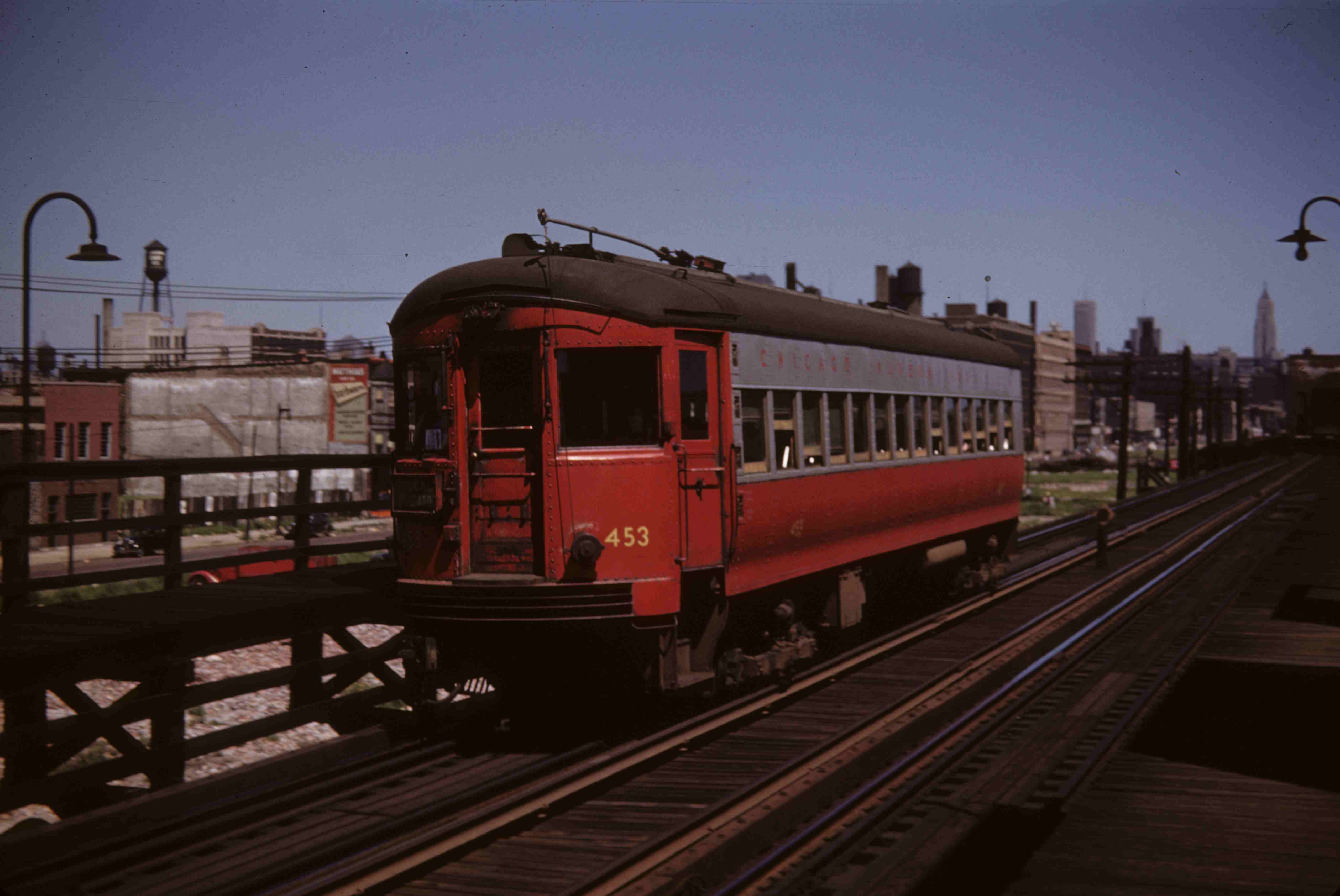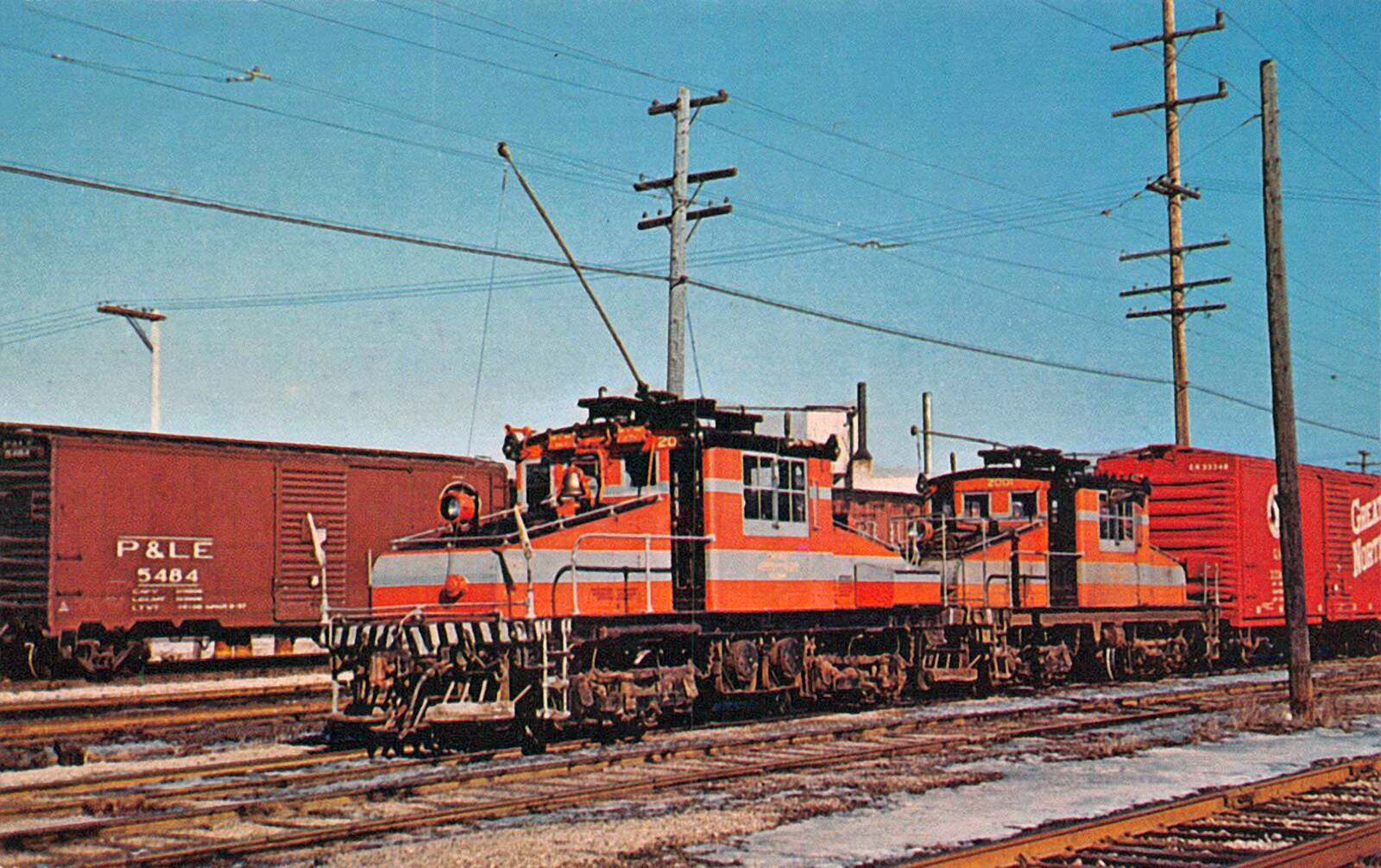The best things in life always come in threes, especially when it comes to competition. Motor racing has the "Triple Crown" of Monte Carlo, Indianapolis, and Le Mans. Horse racing has the Belmont, Preakness and Kentucky Derby stakes, and even down to electric railways in hot contention for the Charles A. Coffin Gold Medal for Innovation and Speed in Electric Railways, utilities magnate Samuel Insull had the "First and Fastest" triple crown of the North Shore line, the South Shore, and the Chicago Aurora and Elgin. Of the three, the "Roaring Elgin" was not as fast as the North Shore, nor as dependent on freight like the South Shore, but its importance in building the Fox River Valley's many cities cannot be understated. Though the shortest-lived of the three Insull-ar roads, the Great Third Rail still holds a place in interurban history.
 |
Streetcars at Fountain Square, Elgin, in 1890. The huge metal frame is part of an electric arch light tower.
(Elgin History) |
Streetcars began running on the CA&E in 1876 when Bruce Payne (not Wayne) began a public horsecar line in Elgin. A man named Col. Evans followed this endeavour in 1882 by setting up a horsecar in Aurora. Between the two lines was the Batavia, Geneva, and St. Charles going north from Aurora along the Fox River valley, and the two horsecars quickly linked up as a riverside streetcar line. Electric railways were never quite secure in the valley, however, as the 1890s were spent with three different companies attempting to connect the riverside system to the main hub in Chicago. This changed on February 24, 1899, when members of the Everett-Moore syndicate from Cleveland, OH, incorporated the Aurora & Chicago and Elgin & Chicago Railways.
 |
A postcard of the Fox River Valley's Island Park in
Geneva, IL, mid-1900s.
(Hip Postcard) |
Immediately after, the Pomeroy-Mandelbaum Syndicate (also from Cleveland) filed incorporation of their new railway, the Chicago, Wheaton & Aurora (CW&A), to compete with the Everett-Moore. Both syndicates had plenty of money, enough city franchises, and all the private right of way set aside to make the new Fox River railways more well-funded than any interurban before or after it. Despite the reason for the CW&A being out of sheer competitive spite, Everett-Moore shot back by incorporating a third company, the Aurora, Wheaton & Chicago (AW&C), on March 11, 1899. Clearly, transit trademark name infringement was easier to get away with if you just change the arrangement of destinations.
Construction was not without its difficulties; although both syndicates had gathered franchises from every city they served, some communities like Cicero Township (now Oak Park and Austin, Chicago) rejected ordinances to have both railroads passing through. The township board's president, a man named Lewis, reasoned that what both railroads offered did not positively affect the town in any way, by fare or by service. This was a major issue as both had to pass through Cicero to reach the famous Chicago Loop. By the end of the month, the AW&C was granted the franchise on the condition of building five new stations in the town and providing streetlights on every alleyway or street it crossed.
 |
Metropolitan West Side Elevated No. 800 at Glenwood Park
on the CA&E Batavia Branch. The car is a product of the
Barney & Smith Company, photo is mid-1900s.
(Don Ross) |
By the turn of the century, the hot competition between the Syndicates seemed to have cooled and both had an unspoken understanding of their common goal. When construction started east out of Aurora on September 18, 1900, it all seemed to be going well until they realized that two cemeteries lay right on their right-of-way, specifically east of the Des Plaines river. As the syndicates finagled a deal of buying land and exhuming the dead, the Everett-Moore syndicate charted its final line called the Batavia & Eastern Railway Company (B&E) which would go between Batavia and the Aurora Branch on the southern end of the line. Land for a new powerhouse was also purchased in Batavia.
 |
A map of the Great Third Rail from 1936,
showing all its active branches.
(Public Domain) |
On March 12, 1901, both syndicates met to decide what to do with the now five companies building towards Chicago. After much deliberation, it was decided to merge the CW&A, AW&C, B&E, Aurora & Chicago and the Elgin & Chicago into one big company: The Aurora, Elgin, and Chicago (AE&C). Not QUITE the name we know, but close enough. After this, work had to stop in the winter of 1902-1903 when heavy snow forced construction crews to delay grading work. It was decided early on that the railway would use high-voltage AC transformed down to low-voltage DC delivered by a third rail, with the transformation occurring at the powerhouse in Batavia. Through this, the AC could be transmitted over the whole line, then transformed at different substations for an effective high speed interurban operation, something the world had never seen before. City tracks would be handled by overhead wire for safety reasons.
 |
Car No. 10, built by the Niles Car Co., out on an
inspection tour fresh after delivery in August 1902.
(Public domain) |
However, by early 1902, the Everett-Moore Syndicate had to back out of the project. Bad business deals with the Bell Telephone Company sent the Syndicate's finances into a spiral and it had to sell everything, including its controlling interest the AE&C. Now under the sole ownership of the Pomeroy-Mandelbaum, the AE&C put an order in to the G.C. Kuhlman Car Company for thirty interurbans, but this deal fell through for unknown reasons. This left the Niles Car Company contracted for ten passenger cars, six of which arrived on the new line that July. Due to electrical problems involving faulty insulators and 250 utility poles burning to the ground, a steam locomotive had to guide inspection trips between the Metropolitan West Side Elevated junction at 52nd (now Laramie) Avenue, Chicago, and Aurora.
 |
A CA&E Timetable from 1936.
By this point, trains were so
frequent, the railroad had
12 pages of schedules per
pamphlet.
(Public Domain) |
The final problem hitting construction of the line was the lack of qualified motormen in the immediate area that either lived in Fox Valley or Chicago. Instead, sixteen "near untrained" motormen were hired from the Pomeroy-Mandelbaum's area of Cleveland, OH, to operate the line when service to Aurora opened on August 25, 1902. Fares were originally set at 25 cents one way and 45 cents round trip, with a 5 cent transfer to the West Side Elevated at 52nd street. The line became so successful in its initial period that the competing Chicago, Burlington & Quincy (CB&Q) line between Aurora and Chicago experienced a significant drop in passenger use. At one point, a train left 52nd Avenue station every 15 minutes, alternating between Aurora and Elgin, with services averaging at 65 miles per hour. The services was so rapid, the Chicago Record Herald allowed the trains to also deliver newspapers down the line in October 1903.
The Aurora, Elgin & Chicago held a unique place among interurban railroads for primarily being 3rd rail, a standard usually held for elevated railroads and subway systems. Trolley wire was used when necessary when running in towns, but the third rail allowed the "Great Third Rail" to eventually connect through 52nd Avenue and access the loop by March 11, 1905. However, years of good fortune turned for the railroad when it entered bankruptcy in 1919. This resulted in abandonment of passenger service on the Fox River Line between Aurora and Elgin via Batavia (operating as the Aurora, Elgin & Fox River Electric) and reorganization of the company by July 1, 1922 as the Chicago, Aurora & Elgin (CA&E) at last.
 |
Aurora, Elgin & Fox River No. 49 working the Fox River Line at Coleman in 1949.
The line was freight only at that point and parts would be preserved by the Fox River Trolley Museum.
(Don Ross) |
 |
A blotter sheet from 1950, courtesy of General Freight
Agent George Sisk, shows all three Insull lines in operation.
(Gil Elvgren) |
Samuel Insull would add the CA&E to his interurban roster in 1926, around the same time he acquired the South Shore line. Due to the lateness in acquiring the "Roarin' Elgin", the Stock Market Crash of 1929 quashed whatever plans he had of heavily improving the line much like the South Shore and he was forced to sell it in 1932. This did not stop the CA&E from coming in third the "First and Fastest" awards several times, just behind the South Shore and North Shore, but it also could not save the railroad's financial situation as it was bankrupt shortly after Insull sold it
.
Prior to Insull's purchase, the railroad ran with the same 1902-vintage cars from the Niles Car Company. These cars were dubbed "mini-Pullmans" for their lavish interiors and could seat 52 people, or 46 if it was a combine-baggage. The John Stephenson Car Company of New York City provided the remaining order of 15 cars, numbered 30-58. When service expanded in 1906 to include the Chicago Loop, new 300-series cars were built by Niles as cars 300-308 in 1906, Kuhlman as 311-315 in 1909, and Jewett as 316-321 in 1913-1914. Cars were also acquired from the North Shore Line between 1907 and 1910, leading to the nickname "North Shore Woods"
 |
Chicago, Aurora & Elgin 309 at the Illinois Railway Museum, in standard configuration with another car, 2008.
(Hicks Car Works) |
 |
Aurora Elgin & Chicago No. 109 in
funerary car service.
Note the large baggage door and
stained glass arch windows.
(Third Rail Cook Book) |
One unique car in the Elgin's collection was 100-series No. 109, originally built by the Stephenson Car Company in 1902 and rebuilt by the AE&C in 1906. This was one of a unique number of "funeral" cars around the United States run in conjunction with cemeteries on Chicago's West Side. It was an insular car, as its couplers were only compatible with Metropolitan "L" cars, and it received a large baggage door for loading and a somber black livery with stained glass arched windows. When the Joint Funeral Bureau was dissolved in 1923, 109 was returned to the Roarin' Elgin and removed from service. Its rebuilding into a flatcar by 1937 further highlighted the difficulty of running a funeral car in normal service.
 |
St Louis Car Co-built steel interurban No. 453 works solo
on the Chicago Loop, August 6, 1950.
(Henry Strange) |
Around the time the 109 was retired from service, the Great Third Rail had invested in a brand-new order of 20 steel cars from Pullman in 1923. The new 400 series developed 560 horsepower from its four GE 254 motors, easily capable of keeping up with the railroad's demanding 15-minute interval schedule. While they were less lavish than the 300-series, the public and motormen still loved them. CA&E would further expand their steel car fleet with orders from Cincinnati, Niles, and St. Louis Car Co. The last of these were built late into 1945 and featured a modern style of curved steel sides and a striking red and white paint scheme that was originally applied to modernized 300-series cars, and would be the last standard interurbans ever built in the United States.
 |
GE steeplecabs 2001 and 2002 work the Indiana Harbor Belt
interchange in March, 1959. These locomotives were also
fitted with third rail shoes.
(George Lloyd) |
The Roarin' Elgin even tried its hand at working freight operations using two GE steeple cabs (2001, 2002), two Baldwin-Westinghouse steeple cabs (3003 and 3004) and ex-Oklahoma Railway electric locomotives purchased from the Cedar Rapids and Iowa City (4005 and 4006). The road primarily worked with boxcars, gondolas, and flatcars with most being retired in the late 1940s. Freight was not as crucial to the railroad like it was with the South Shore, as commuter passenger rail to the Fox River Valley was usually the money maker and top priority.
 |
Pullman Steel car No. 427 leads a 4-car train westbound at
De Plaines in September 1954. The train above is a CTA
Garfield Park service which would soon be diverted onto
temporary track.
(Unknown photographer) |
However, the good times could not last forever. Wartime brought a limited hope to the railway but even with increased passenger and freight haulage, they could not escape the bankruptcy hell Samuel Insull had to leave them in more than a decade prior. The construction of the new Congress Park Expressway (now the Eisenhower Expressway) in 1951 ended up demolishing the Garfield Park Elevated Station, now cutting the railroad off from the Chicago Loop. A freeway median strip was offered, but CA&E objected to the street-running cutting severely into their fast schedules and screwing them out accessing their Wells Street Terminal. As it was in 1905, passengers now had to change trains at Forest Park Terminal and ride the Chicago Transit Authority (CTA) to the Loop.
 |
The Chicago Daily Tribune's
big story on July 4, 1957.
So much for Independence Day
commuters.
(Chicago Daily Tribune) |
The CA&E limped along through the 1950s, still a shadow of its former self and still not out of bankruptcy. By 1957, the Illinois Commerce Commission finally granted them the terms for abandonment and the CA&E decided to pull service in just the most "go to hell" fashion they could. Passenger groups and affected municipalities tried to plead the railroad to keep service going through injunctions, but it was no use: when the clock struck noon on July 3rd, 1957, the Great Third Rail swept the rug out from under everyone and just stopped running trains altogether. Commuters heading home to the Fox River Valley now had no way to travel and the CA&E remains the only interurban known to me to just abruptly stop service. Freight service continued until June 10, 1959, and the abandonment was rendered official on July 6, 1961, when the real estate was passed through to the Aurora Corporation of Illinois, yet another syndicate.
Today, 19 pieces of the original Chicago, Aurora & Elgin survive in various museums, the most being the Illinois Railway Museum which owns and operates regularly 9 different cars spanning the 300-series and 400-series cars. Fox River Trolley Museum in South Elgin, IL, owns five cars in their home town, and the Rockhill Trolley Museum in Rockhill Furnace, PA, owns wooden car 315. (Incidentally, the Philadelphia Suburban Transportation Authority wanted to buy some Elgin cars for the Norristown High Speed Line but they went for the Electroliners instead.) Service between Chicago and Fox River Valley is now run by the Chicago Metra Union Pacific/West Line. So goes the Roarin' Elgin, now quieted.
 |
CA&E No. 20, one of the oldest wooden cars surviving from the railroad, works its old
interurban line at the Fox River Trolley Museum, South Elgin, IL, July 1966.
(Roger Puta) |
-----
Not to worry, dear readers! We'll never leave you hanging! I'd like to credit
Jonathan Lee for serving as this month's Chicago transit expert, and if you'd like to know more about what you've read here, hit up the
Illinois Railway Museum and the
Fox River Trolley Museum on their respective websites. We finish our ride on the Chicago interurbans on Thursday with an overview of the CTA, but until then you can follow
myself or
my editor on twitter if you wanna support us, and maybe
buy a shirt as well! Ride safe out theah!














No comments:
Post a Comment